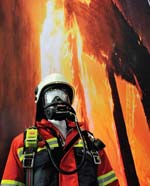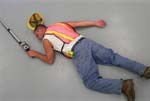
Ensuring Industrial Lone Workers' Safety
Your company's safety managers should perform a thorough needs analysis and develop a set of performance criteria for the life safety notification system.
- By Craig A. Walker
- Jan 01, 2010
This article focuses on the issue of lone worker safety in the industrial workplace in industries both large and small. The first point of order is to define just what is meant by a "lone worker." At first glance, most safety managers and other supervisory personnel will tell you that no one works alone in their facility — the work is performed in teams, or there are a number of employees on the work fl oor at any given time. As the discussion goes into more depth, instances of personnel working alone are more common than first thought.
Some examples include a single worker reporting to the boiler room or electrical control room, or even a remote building at a facility. Many facilities have one or two employees working the midnight shift, often at opposite ends of the building. What happens if one or more of these employees is injured, has a medical emergency such as a heart attack or stroke, or is otherwise incapacitated? Workplace death and injury studies commonly report cases where a worker was working alone, even for a short period of time, and suffered a catastrophic medical emergency or injury, and whose condition was not discovered for several hours. Far too often, the worker was deceased when eventually found because there was no automated mechanism to call for help when the worker could not. In today's modern world of technology, this is simply not acceptable.
Outmoded Solutions
An example of how technology has not caught up with the lone worker phenomenon can be seen in most industrial facilities. In some cases, as personnel report in for their shift, they remove a brass tag from an "off-shift " board and place it on the "on-shift " board. Another instance that has been observed is confined space entry, where a similar system is in place at each entry point into the confined space.
Once these employees begin working, it is often the case that the only indicator of a potential problem is if one or more employees do not check out at the specified time. It is only then that the search-and-rescue effort begins. Lacking the ability to provide immediate notification of a worker in distress condition, the best you have at the end of the day is a list of potential victims.
Many times, the answer is that the employees are equipped with hand-held portable radios or cellular telephones. If an employee is unconscious, those radios or cell phones are of absolutely no value. The ultimate answer is to utilize a system that can provide automatic notification of an employee distress condition. Such a system offers the highest probability of survivability for an injured or medically distressed worker.
Another potential problem area to consider is the event of an emergency at the facility that warrants immediate evacuation. A hydrogen sulfide leak at a petroleum refinery, a fl ammable or hazardous material spill at an industrial facility, and an overpressure of a boiler or steam line are just a few scenarios that would require prompt evacuation of a general area or entire facility. I am sure that you can easily envision several others.
 Some of the standard operating procedures that are commonplace in industry are whistles or sirens, PA system announcements, and portable radios. In an emergency situation, the whistle, horn, or siren may not be heard above ambient industrial noise, especially if hearing protection is in use. The PA system may become damaged or may not work in all areas, and the portable radio most likely will not do the trick. Each individual should be equipped with a device that is part of a dedicated worker distress system that can perform this critical function, independent of whatever else is occurring at the time.
Some of the standard operating procedures that are commonplace in industry are whistles or sirens, PA system announcements, and portable radios. In an emergency situation, the whistle, horn, or siren may not be heard above ambient industrial noise, especially if hearing protection is in use. The PA system may become damaged or may not work in all areas, and the portable radio most likely will not do the trick. Each individual should be equipped with a device that is part of a dedicated worker distress system that can perform this critical function, independent of whatever else is occurring at the time.
Return on Investment
As is the case with any expenditure for new equipment, budget is always a concern. This is especially true in today's economic climate. The question is, however, what is the cost of not employing such a system? Consider just a few possibilities of the costs that may be prevented:
- Loss of work time in the event of an injury
- Disability claims
- Worker's compensation expenses
- Medical expenses
- Hiring and retraining costs in the aftermath of a worker death or disabling injury
- Potential for civil liability and associated legal expenses in the event a death is deemed preventable
- Federal and/or state OSHA citations
The old saying that "an ounce of prevention is worth a pound of cure" could not be more relevant. Being proactive to prevent workplace tragedies is far better than being reactive aft er a tragedy, or even a near tragedy, occurs.
System Considerations
If your company decides to take the proactive approach, it is crucial to select the right system. Your work operations, personnel complements, shift structure, and emergency procedures — all of these must be considered. You will certainly not want a system that requires you to reconfigure your standard operating procedures to fit the technology. Rather, you want technology that will fit as seamlessly as possible into your day-to-day operations.
One of the most popular systems commercially available is a wireless system. Wireless systems are generally easily installed and offer components, such as signal repeaters, that ensure maximum signal propagation in virtually any setting or environment. The better- performing systems utilize solid-state accelerometers to detect the lack of motion, thereby initiating the Worker Distress Alarm. Variable motion time-out options help ensure that nuisance alarms are greatly reduced or nonexistent. The Worker Distress Alarm units themselves can be activated or switched on either automatically or manually, depending on company preference.
Each brand has its advantages and disadvantages, including ease of installation and cost of retrofitting. Some key elements to consider in your selection process for a worker distress and life safety system include:
- Can the solution provide the identities of those personnel working at the facility, independent of voice radios, tag systems, or other mechanical means?
- Does the solution provide for immediate notification of one or more employees in distress?
- Can an employee depend on both a manual "Call For Help" feature and an automatic Distress Alarm activation, in the event the employee is unable to activate the Distress Alarm manually?
- Does the solution provide the employee identities of those in a distress situation?
- Can the solution, independent of voice radios or other mechanical devices, initiate and order an evacuation?
- If radio frequency technology is integral to the system, can the solution be made to have sufficient range and signal penetration to accommodate your needs?
- Does the solution have the capacity to process the number of personnel that may be operating at a large-scale work operation?
- Does the solution provide a means to interface with existing building alarm systems or systems control and data acquisition (SCADA) systems, or utilize an automated telephone dialer at facilities where there is only one worker?
The above factors are neither all encompassing nor all inclusive. Your company's safety managers or safety team should perform a thorough needs analysis and develop a set of performance criteria for the life safety notification system. Every company is unique in nature and operates under its own conditions and circumstances. So your solution must be able to meet your needs as near to 100 percent as possible.
This article originally appeared in the January 2010 issue of Occupational Health & Safety.